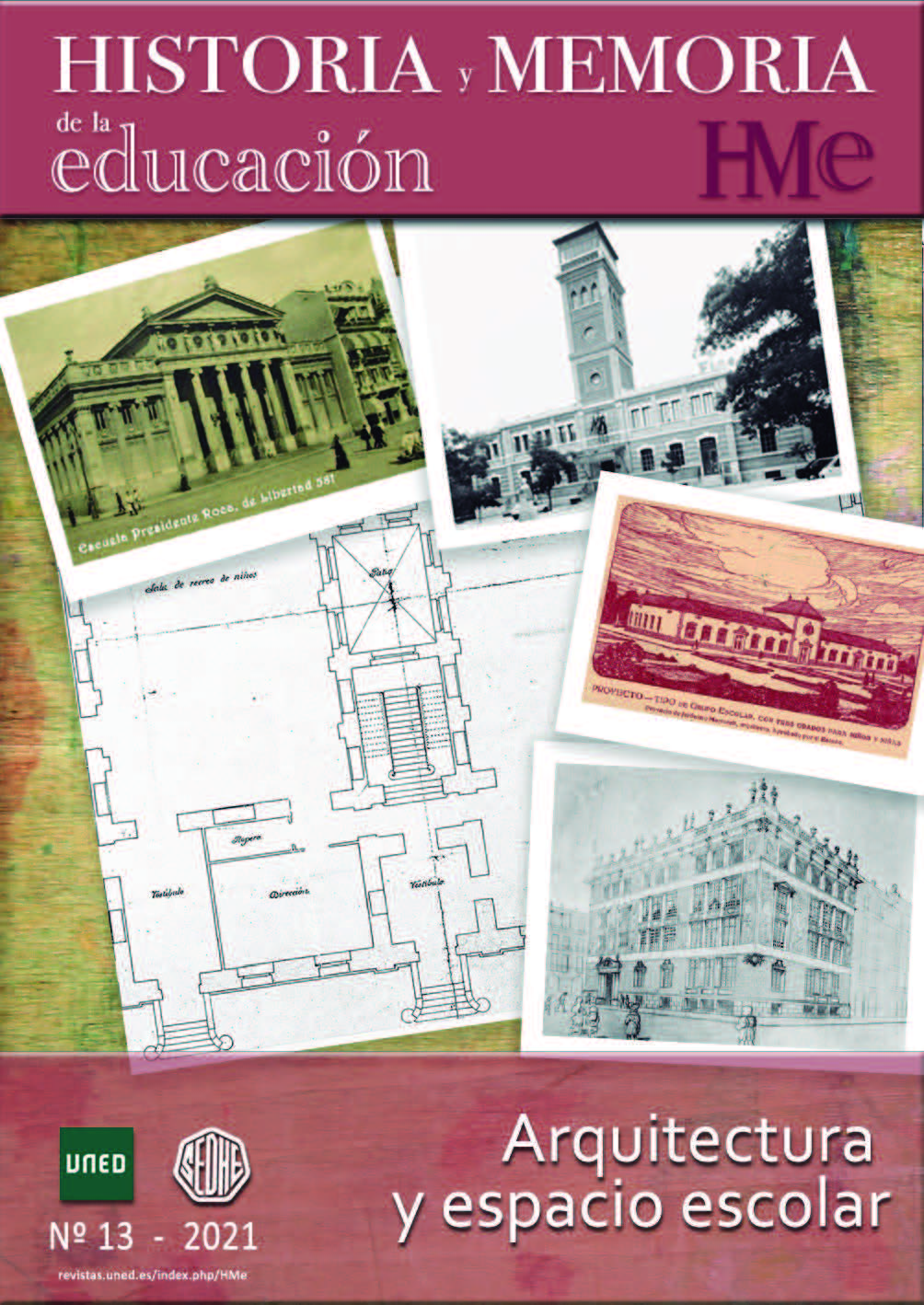«Escuelas al aire libre» - Un «nuevo» espacio para la reforma educativa y la vuelta a la naturaleza en el período de entreguerras en Checoeslovaquia (ejemplos de los Sudetes alemanes y checos)
DOI:
https://doi.org/10.5944/hme.13.2021.27181Palabras clave:
educación progresiva, reforma escolar, Movimiento de vuelta a la naturaleza, Checoslovaquia, escuelas al aire libre, arquitectura escolarResumen
El estudio analiza dos ejemplos de las llamadas escuelas al aire libre en Checoslovaquia en el período de entreguerras — un ejemplo checo de la «nueva educación» y otro de los Sudetes alemanes. El artículo presenta dos ejemplos seleccionados de reforma de la escuela como un lugar de la «nueva educación» y analiza su arquitectura en relación con el concepto de educación, el problema de la educación del «nuevo hombre» en el marco del movimiento de vuelta a la naturaleza, y la concepción y disposición arquitectónica del espacio destinado a la enseñanza. El texto analiza tanto la forma «externa» del edificio escolar como la arquitectura «interna» del pensamiento educativo de los principales protagonistas de ambos ejemplos de reforma escolar: Eduard Štorch y Karl Metzner. Dicho análisis se lleva a cabo en el contexto sociopolítico de Checoslovaquia durante el periodo de entreguerras y de los esfuerzos de reforma de la arquitectura escolar en los primeros años del siglo XX y en el período de entreguerras en Europa Central.
Descargas
Citas
Ash, Mitchell G. and Jan J. Surman. The nationalization of scientific knowledge in the Habsburg Empire, 1848–1918. Basingstoke: Palgrave Macmillan, 2012.
Buchholz, Kai. Die Lebensreform: Entwürfe zur Neugestaltung von Leben und Kunst um 1900. Darmstadt: Wissenschaftlicher Verlag, 2001.
Burke, Catherine, Peter Cunningham and Ian Grosvenor. “‘Putting education in its place’: space, place and materialities in the history of education”. History of Education 39, no. 6 (2010): 677-680.
Caruso, Marcelo. Biopolitik im Klassenzimmer: zur Ordnung der Führungspraktiken in den Bayerischen Volksschulen (1869–1918). Weinheim–Berlin–Basel: Beltz, 2003.
Depaepe. Marc and Bregt Henkens. The Challenge of the Visual in the History of Education. Ghent: CSHP Paedagogica Historica Supplementary Series 6, 2000.
Depaepe, Marc. Zum Wohl des Kindes? : Pädologie, pädagogische Psychologie und experimentelle Pädagogik in Europa und den USA, 1890–1940. Weinheim: Studienverlag, 1993.
Châtelet, Anne-Marie and Andrew Saint. L’école De Plein Air: une expérience pédagogique et architecturale dans l’Europe du XXe siècle = Open Air Schools: An Educational and Architectural Venture in Twentieth-Century Europe. Paris: Éd. Recherches, 2003.
Imhof, Michael. “Stereotypen und Diskursanalyse”. In Stereotyp, Identität und Geschichte. Die Funktion von Stereotypen in gesellschaftlichen Diskursen, edited by Hans Henning Hahn, 57-72. Frankfurt am Main: Peter Lang Verlag, 2002.
Hahn, Hans Henning. “Nationale Stereotypen”. In Stereotyp, Identität und Geschichte. Die Funktion von Stereotypen in gesellschaftlichen Diskursen, edited by Hans Henning Hahn, 17-56. Frankfurt am Main: Peter Lang Verlag, 2002.
Haslinger, Peter. Nation und Territorium im tschechischen politischen Diskurs: 1880–1938. München: Oldenbourg, 2010.
Judson, Pieter M. Guardians of the Nation: Activists on the Language Frontiers of Imperial Austria. Cambridge: Harvard University Press, 2006.
Judson, Pieter M. and Marscha M. Rozenblit. Constructing Nationalities in East Central Europe. New York: Berghahn Books, 2005.
Kasper, Tomáš. “Eduard Štorch’s New School as an Example of a School Reform Experiment in Interwar Czechoslovakia”. In Hidden Stories – the Life Reform Movements and Art, edited by Beatrix Vincze, Katalin Kempf and András Németh, 159-175. Berlin: Peter Lang, 2020.
Kasper, Tomáš. “The Sudetendeutsche Jugendgemeinschaft: the ideological and organisational platform of the Sudeten German youth movement and its means to create the Sudetendeutsche Volksgemeinschaft”. Paedagogica Historica (2019), in print
Kasper, Tomáš and Dana Kasperová. “Development and Focus of Czech Pädagogik in the Late 19th and Early 20th Centuries”. In Education and “Pädagogik”– Philosophical and Historical Reflections (Central, Southern and South-Eastern Europe), edited by Blanka Kudláčová and Andrej Rajský, 194-209. Berlin: Peter Lang, 2019.
Kasper, Tomáš and Dana Kasperová. “Exactness and Czech Pedagogy at the Break of the 19th and 20th Century”. History of Education and Children’s Literature 12, no. 2 (2017): 343–358.
Kasper, Tomáš. “Die deutsche Jugendbewegung in der Tschechoslowakei 1918–1933”. In Jugend in der Tschechoslowakei. Konzepte und Lebenswelten 1918–1989, edited by Christianne Brenner, Karl Braun and Tomáš Kasper, 25-59. Göttingen: Vandenhoeck & Ruprecht 2015.
Kasper, Tomáš and Dana Kasperová. “National, state and civic education in the Czech Lands of Austro-Hungarian Empire in Czechoslovakia after 1918”. History of Education and Children’s Literature 10, no. 1 (2015): 251–278.
Kerbs, Diethart and Jürgen Reulecke. Handbuch der deutschen Reformbewegungen 1880–1933. Wuppertal: Hammer Verlag, 1998.
Křen, Jan. Die Konfliktgemeinschaft. München: Oldenbourgh, 1996.
Lawn, Martin and Ian Grosvenor. “Imagining a Project: Networks, Discourses and Spaces – Towards a New Archaeology of Urban Education”. Paedagogica Historica 35, no. 2 (1999): 380-393.
Mayer, Christine. “The experimental and community schools in Hamburg (1919–1933): an introduction”. Paedagogica Historica 50, no. 5 (2014): 561–570.
Mayer, Christine. “Circulation and internationalisation of pedagogical concepts and practices in the discourse of education: The Hamburg school reform experiment (1919–1933)”. Paedagogica Historica 50, no. 5 (2014): 580–598.
Oelkers, Jürgen. Reformpädagogik: Entstehungsgeschichten einer internationalen Bewegung. Zug: Klett und Balmer, 2010.
Puschner, Uwe and Ulrich G. Großmann. Völkisch und national. Darmstadt: Wissenschaftliche Buchgesellschaft, 2009.
Richardson, Theresa. “The Home as Educational Space: Bayonne Housing and the Architecture of Working Class Childhood, 1917–1940”. Paedagogica Historica 36, no. 1 (2000): 299–337.
Skiera, Ehrenhard. Reformpädagogik in Geschichte und Gegenwart: eine kritische Einführung. München: Oldenbourg, 2010.
Stambolis, Barbara. Der Mythos der Jugend. Ein Aspekt der politischen Kultur im 20. Jahrhundert. Schwalbach: Wochenschau Verlag, 2003.
Šimek, Jan. Historie školních budov [The History of School Buildings]. Praha: NPMK, 2016.
Descargas
Publicado
Cómo citar
Número
Sección
Licencia

Reconocimiento – NoComercial (by-nc 4.0): Se permite la generación de obras derivadas siempre que no se haga un uso comercial. Tampoco se puede utilizar la obra original con finalidades comerciales.










